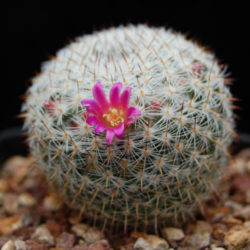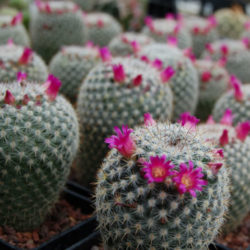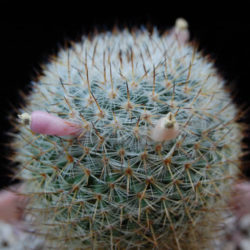Scientific Name
Mammillaria halbingeri Boed.
Synonym(s)
Neomammillaria halbingeri
Scientific Classification
Family: Cactaceae
Subfamily: Cactoideae
Tribe: Cacteae
Subtribe: Cactinae
Genus: Mammillaria
Origin
This species is native to Mexico (near Ocotepec in Oaxaca). It occurs at an elevation between 6600 to 8200 feet (2000 to 2500 m) above sea level.
Description
Mammillaria halbingeri is a small cactus with light green globose to short cylindrical stems with conical to ovoid tubercles, wooly axils, and needle-like spines. At first, it grows solitary but later forms clumps. The stems grow up to 4 inches (10 cm) tall and up to 3.2 inches (8 cm) in diameter. There is a cluster of usually 2, sometimes one central spine, and 21 to 28 radial spines on each areole. The central spines are white to yellowish-white, with brown tips, slightly curved, and up to 0.4 inches (1 cm) long. Radial spines are thin, white, and up to 0.3 inches (0.8 cm) long. Flowers are sulfur yellow with pale pink margins or pink to magenta, funnel-shaped, and up to 0.5 inches (1.2 cm) in diameter. They appear arranged in a circle around the stem below the apex in spring. Fruits are small, whitish, and contain brown seeds.
Etymology
The specific epithet "halbingeri (hal-BING-er-ee)" honors Christian Halbinger (1884–1976), a botanist born in Germany who moved to Mexico in 1906.

How to Grow and Care for Mammillaria halbingeri
Light: Plant this cactus in an area of your garden that receives 4 hours of direct sunlight a day. If you are growing M. halbingeri indoors, place it near the brightest window in your home or office to ensure your cactus gets enough light. If possible, place the pot on the balcony or in the garden for extra light from spring to fall.
Soil: M. halbingeri requires a soil mix that provides root aeration and good drainage, whether grown outdoors or indoors. Use commercial cactus potting mixes or create your own potting mix.
Hardiness: This cactus is heat tolerant but is not a cold-hardy plant. M. halbingeri can withstand temperatures as low as 25 to 50 °F (-3.9 to 10 °C), USDA hardiness zones 9b to 11b.
Watering: From spring to fall, water deeply and wait for the soil to dry out before watering again. Never let the pot sit in water. Suspend watering in the winter.
Fertilizing: M. halbingeri can benefit from fertilizing during the growing season. Apply a water-soluble fertilizer for cacti and other succulents. Suspend feeding during the winter when the plant goes dormant.
Repotting: Repot every two or three years into a slightly larger pot. The best time to repot your M. halbingeri is late winter or early spring, but the repotting process can be done almost any time of the year.
Propagation: There are two easy ways to propagate M. halbingeri: by seeds or by dividing offsets. The best time to remove offsets is in spring and summer. Sow the seeds in late spring or summer.
Learn more at How to Grow and Care for Mammillaria.
Toxicity of Mammillaria halbingeri
M. halbingeri is considered non-toxic to both humans and pets.
Links
- Back to genus Mammillaria
- Succupedia: Browse succulents by Scientific Name, Common Name, Genus, Family, USDA Hardiness Zone, Origin, or cacti by Genus
Photo Gallery
Click on a photo to see a larger version.


